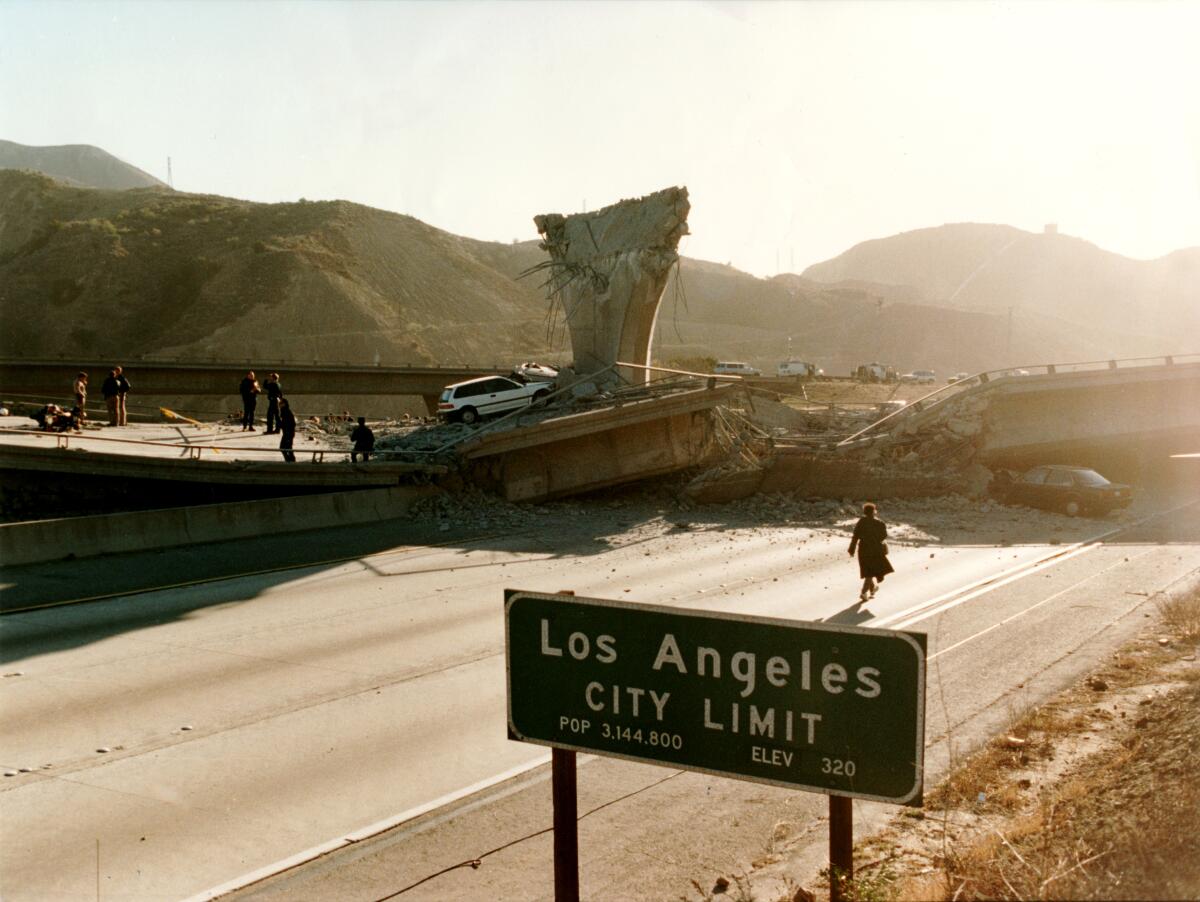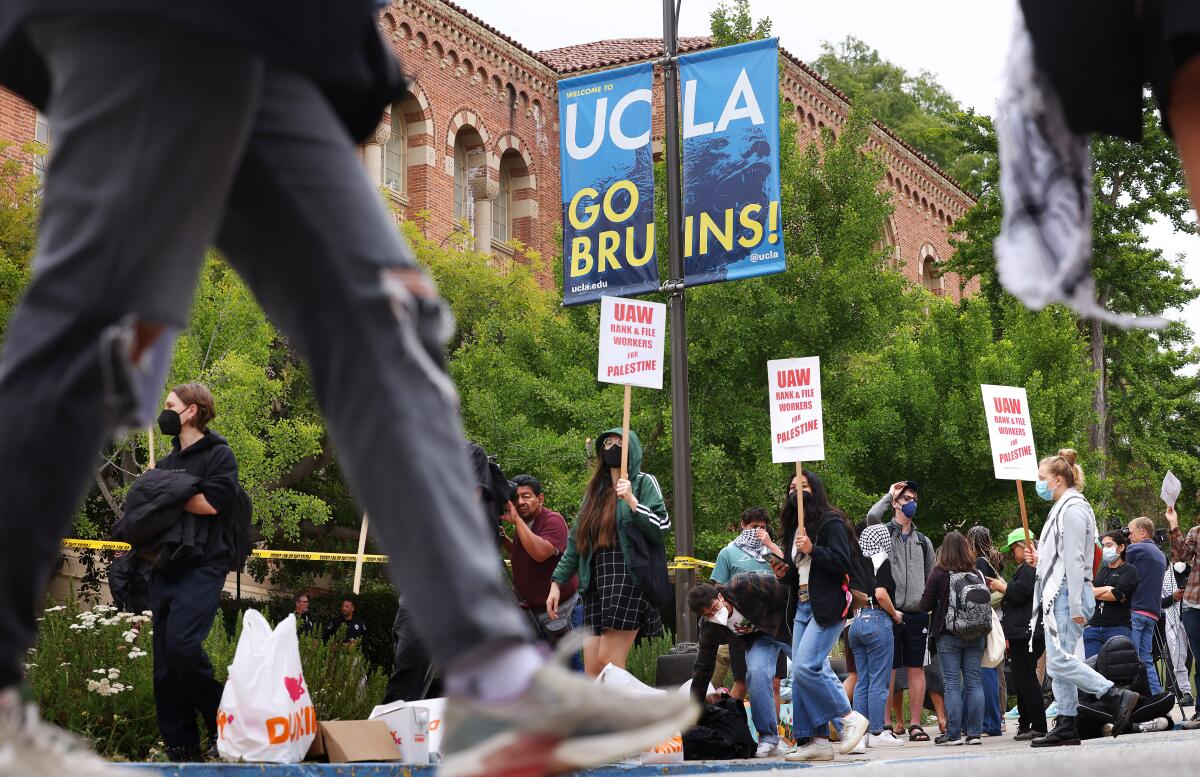Good morning. It’s Tuesday, Aug. 20. Here’s what you need to know to start your day.
Even little earthquakes are a big deal these days
My first indication of last week’s magnitude 4.4 earthquake came from the L.A. Times’ Slack messaging system. Colleagues in Hollywood, Highland Park, Pasadena and other locations near the epicenter reported feeling the jolt several seconds before the shaking made its way to my house in Long Beach.
The newsroom sprang into action. No damage. No injuries. A minor “chandelier rattler” if there ever was one. But our five stories on the quake included the names of more than a dozen reporters and editors contributing to the coverage.
This is now our playbook. Earthquakes — even relatively small ones — are huge news in California.
I am old enough to remember it was not always this way.

The junction of the 5 and 14 freeways on Jan. 17, 1994, after the Northridge quake. (Steve Dykes / Los Angeles Times)
The L.A. Times used to be a quake denier
There was a time when anything less than a magnitude 5.0 merited only a news brief and “Did you feel that one?” small talk at the supermarket checkout line. But social media, major advances in seismic technology (remember how long it used to take to figure out the epicenter and magnitude?) and our growing obsession with California catastrophe changed all that. The Times now has a robot that “writes” the first take on an earthquake so we can get the news up fast.
While our readers flock to this coverage, some news traditionalists roll their eyes at how much we write about what they consider minor news. Are you just trying to gin up web traffic? What will happen when there really is a big one?
Seismic obsession is relatively new for L.A. newspapers.
For many decades, The Times and other news organizations downplayed the risk of big quakes in the region, fearful it would drive away tourists and residents. When San Francisco was flattened in 1906, L.A. papers insisted it could not happen here; “Earthquakes in Southern California do not occur often and do not destroy human life,” The Times declared.
When Long Beach was hit by a deadly temblor in 1933, it generated banner headlines. But The Times also castigated the “East Coast” for exaggerating the scale of the devastation and the death toll under the headline “Yes, but where is all the damage?” A running theme was that rival cities like Miami were purposely planting false stories about L.A.’s quake risk to scare people away.
The one exception came when a phantom quake could cover up corruption, as Paul Haddad notes in his excellent history of early Los Angeles, “Inventing Paradise.” Hoping to justify L.A.’s notorious taking of water from the Owens River hundreds of miles away, The Times suggested the river once flowed toward Los Angeles but that a massive quake caused mountains to rise up and block it.
“No geologists were quoted,” Haddad noted.
When it comes to quakes, denial is dangerous
California media’s approach to earthquakes began changing in the 1970s when a series of big temblors made seismology a political issue. The 1971 Sylmar quake revealed serious flaws in some very popular building techniques. A brand-new hospital made of concrete collapsed, along with many unreinforced masonry structures. The Times and other papers helped expose the weaknesses. L.A. eventually required thousands of old brick buildings to be retrofitted.
Then came three destructive quakes in a seven-year span — the Whittier Narrows in 1987, Loma Prieta in 1989 and Northridge in 1994. This sparked the biggest seismic safety campaign yet, eventually covering freeways, bridges and hospitals.
But there has not been a huge quake in the heart of our most populous urban areas since, and some seismic safety efforts have slowed in California.
The biggest seismic danger we face is denial, putting the risks out of our minds rather than working together to make our city safer. Each tremor is a chance to talk about the risk, look at how we can protect ourselves better and do some basic seismology education. An effort by The Times a decade ago helped lead L.A. to require retrofits to thousands of vulnerable buildings.
And quake denial takes many forms. In 1974, Times writer Jack Smith took his daughter-in-law from France to see the disaster flick “Earthquake!” at the Chinese Theater in Hollywood. It was a surreal experience, being in Hollywood, watching filmmakers destroy Hollywood with a killer quake, demolishing everything including the Capitol Records building just down the street.
Afterward, Smith wrote, his young daughter-in-law asked that they drive past the landmark building. “I’d just like to see if it is still there. It would make me feel better.”
It was, and both of them breathed a bit easier.
But the fictionalized terror of earthquakes should not sidetrack us from the real threat. When it comes to Hollywood, The Times’ own reporting shows that earthquakes are definitely alarming, but it is also within our means to make our structures better and safer.
If California’s seismic history shows, fear is the ultimate motivator.
Today’s top stories

UCLA protesters gather on campus as a pro-Palestinian encampment is built on May 23, 2024. (Christina House / Los Angeles Times)
New protest rules at the University of California
The first night of the DNC
Cops and law enforcement
More big stories
No comments:
Post a Comment